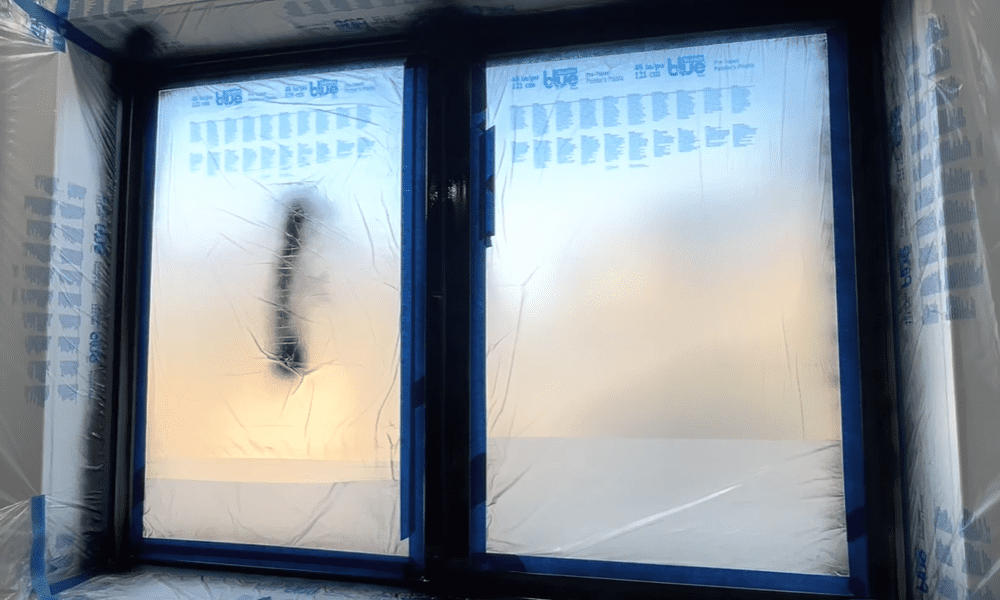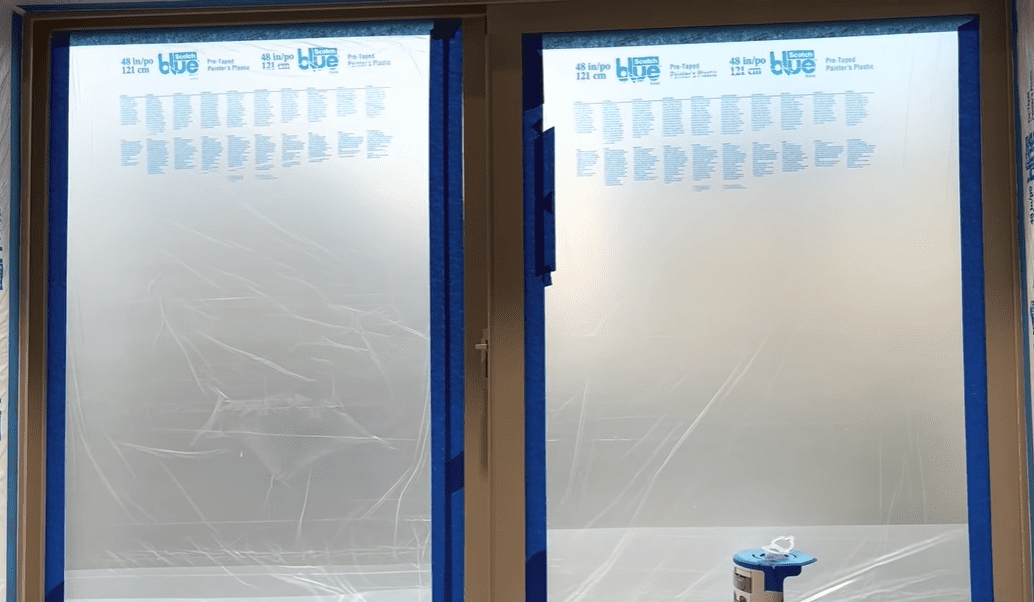If you have installed vinyl window frames that look dull and worn after a while, you probably wonder can you paint vinyl windows. Even though window manufacturers disagree, painting contractors will tell you that this project is possible and can be successful.
Since the answer is a bit controversial, it seems that each homeowner should make their own decision. You can paint vinyl windows after considering possible risks and preparing adequately. Be aware that such a DIY project is challenging but possible when following instructions, applying particular techniques and using adequate tools. Let’s go!
Table of Contents
Can You Paint Vinyl Windows?
Theoretically, it is possible to paint vinyl windows as a cheap alternative to replacing them, but most manufacturers don’t recommend it. This job is tricky and comes with severe risks, particularly when deciding to paint them after installation. In these circumstances, there is a low chance of being satisfied with the result of your effort.
The crucial problem is that paint can’t adhere well to vinyl because of its shiny finish, slippery surface, and regular shrinking or expansion under different weather conditions.
In most cases, you will get stuck with bubbling and peeling paint, making a window look ugly and unsightly. Plus, unprofessional painting over drainage holes and hardware hinders window opening and closing.
Painting Vinyl Windows Risks
1. It is a difficult DIY job
Unfortunately, vinyl is challenging to paint, making this DIY project hard. You should sand the surface with a minimum of 220-grit sandpaper to prepare it for painting. The next step is to apply a proper vinyl-specific primer and then add a few thin paint layers.
Let each one dry thoroughly to increase the probability of sticking the paint to the window surface. Even if you do everything as recommended, there is a chance that the paint won’t adhere well.
2. Paint doesn’t adhere well to vinyl
The vinyl’s shiny surface look is designed to be appealing and elegant. Unfortunately, the same feature makes it resistant to paint adherence, and you can expect this material to repel most new paints.
Even though you can use specialty paints for vinyl, you can get a messy and short-lived result you won’t be happy with. In most cases, such a project starts with sanding and ends up with paint flaking, peeling, and chipping, making windows look worn, neglected, and old.
3. Flaking and peeling paint
Unfortunately, applied paint can quickly peel off from the vinyl surface since it is not an ideal material for holding it. Most contractors will offer a two-year warranty on the used paint.
However, they will refuse to provide a warranty when an issue on the window directly related to the painting appears. In other words, any peeling and flaking will be a problem you need to solve.
4. Limited colors options
Some manufacturers allow painting vinyl window frames as long as you use precisely determined light colors. Sometimes, they require a paint sample before approving a project without voiding the warranty.
The reason is deforming vinyl window frames painted in dark shades and how they react to solar heat. If the glass breaks down because of warped vinyl, your warranty won’t cover it.
5. Painting may compromise the vinyl
Painting can cause severe damage to the vinyl window frame because you need to sand it before applying paint.
If paint starts peeling, you can remove it, but it is impossible to return the window to its original condition. The only option is to re-paint it after pealing the existing paint off with coarse sandpaper.
6. Painting affects a home’s resell value
Since any damage to windows potentially affects the home’s resale value, you should be careful with painting those made of vinyl. Inadequate paint will negatively affect window appeal and damage its integrity. Plus, a buyer may hate your color choice and the necessity of replacing damaged windows soon.
7. Voiding warranty
You can damage window frames if you are not skillful and don’t have adequate equipment for this complicated job. That will lead to voiding your warranty.
You can expect the same thing when using some low-quality primers that contain harmful chemicals. Believe it or not, some types can reduce vinyl structural integrity, warp, and soften it.
Before painting vinyl windows, contact the manufacturer and ask about possible warranty problems. Be aware that most producers won’t agree to cover any damage that appears because of painting, like chipping, warping, and cracking.
Way to Paint Vinyl Windows
If you are sure that painting your vinyl window frames is the best option for you, it is recommended to follow a few simple steps.
Never apply paint directly to vinyl
Applying paint to the vinyl without preparing it won’t end with a satisfying result. Since paint doesn’t adhere to a smooth, shiny vinyl surface, it will start peeling after a while.
It is necessary to thoroughly clean and send vinyl and apply a primer layer before the chosen paint. Only that way, you have a chance to get windows that look lovely for a few years.
Pick out the suitable primer and paint
Your priority is to find a special primer and paint for vinyl. Nowadays, you can buy vinyl-safe paint in reflective polyurethane enamel, cans, and spray, and a vinyl-safe primer in cans and spray.
Additionally, you should avoid dark colors and use those with a Hunter L value of 60 to 100 for white window frames. Colors with a Hunter L value of at least 40 are adequate for frames painted in sand or terra tones. If you have forest green window frames, you shouldn’t paint them at all.
It is wise to consult with a store associate before buying paint, but neutral colors like beige, gray, and brown are a convenient option for most homes.
On the other hand, dark colors absorb solar heat, lower windows’ energy efficiency, and quickly lead to frame paint’s warping and glass cracking. Therefore, you should avoid black, charcoal gray, and olive green, no matter how wonderful they look.
Aesthetic value
Once you decide to paint vinyl window frames, you should pick out the quality vinyl-safe primer and paint. Inadequate technique and low-quality material applied to vinyl frames will make your windows look ugly and unsightly.
Keep in mind that cheap material can cost you more in the end when starting cracking and peeling after a few days or weeks.
How to Paint Vinyl Windows
Once you decide to paint your vinyl windows, you should follow the recommended procedure. Only that way can you expect to get as successful a result as possible.
Step 1. Wash the vinyl thoroughly
The crucial thing is to clean the window surface as much as possible. Removing the dirt, grime, mildew, and mold will help a primer to adhere to vinyl properly.
It will be enough to mix soap with a few drops of diluted dish soap, pour them into a bucket of water, and wash the frames with a lint-free cloth.
Always rinse the soap, let the windows dry, and then clean the surface with acetone. After it is entirely dry, it is time to start sanding. Never use harsh chemicals to prevent vinyl damage.
Step 2. Remove window’s hardware
Always unscrew complete window hardware to prevent them from getting covered with primer and paint. The best way is to unscrew it, place the removed pieces in a bag, and put them back in place after the job is done.
Step 3. Sand the vinyl window frames
Use a medium-grit (typically 220 or 240-grit) sanding sponge to sand the vinyl until the surface becomes rough. Avoid using coarse sandpaper and hard rubbing to prevent vinyl damage.
Be particularly careful to avoid damaging the glass. Remember to clean off any dust before the next step.
Step 4. Prepare the area
The next step is to use painter’s tape or plastic sheeting and cover areas you don’t want to paint. Carefully tape them over the glass and ensure that every piece of the window frame is uncovered.
Always protect your walls when using spray paint. Finally, put the canvas cloth over the floor to prevent paint from permeating it.
Step 5. Primer for vinyl window frame
You will need a brush or foam roller to apply the primer layer or use a spray if you find this option convenient. Always purchase the vinyl-safe primer specifically made for this material.
For instance, many professionals recommend high-bonding products like oil primer and shellac for this purpose. Let it entirely dry before painting.
Step 6. Paint vinyl window frame
Use a roller or small sponge brush for painting or practical spray paint. Take care to choose a vinyl-safe paint and apply it in two layers, but always wait about three hours to let each one dry entirely before the next application.
Step 7. Remove the tape
Finally, you should carefully remove the tape or plastic sheeting when the window frames are almost dry but the last coat is slightly wet. It is the only way to prevent pulling the paint off.
Summary
Painting vinyl windows is an affordable way to beautify your home, but most manufacturers disagree that it is a wise idea. On the other hand, it can be a possible and convenient DIY project when using a PVC-friendly primer and adequate paint. Check the instructions, be patient and persistent, and it will pay off. Good luck!

